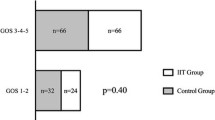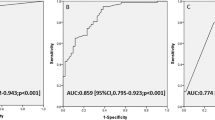Abstract
Purpose
Hyperglycemia in the acute phase after trauma could adversely affect outcome in children with severe traumatic brain injury (TBI). The goal of this study was to identify the relationship between acute spontaneous hyperglycemia and outcome in children with severe TBI at hospital discharge and 6 months later.
Methods
A retrospective analysis of blood glucose levels in children with severe TBI at a Pediatric level I Trauma Center, between January 2000 and December 2005. Hyperglycemia was considered for a cut-off value of 11.1 mmol/l (200 mg/dl). Outcome was measured with Glasgow Outcome Scale (GOS) at hospital discharge and at 6 months. A multiple logistic regression analysis, the Student's t test and the χ 2 test were done.
Results
Hyperglycemia was noted within the first 48 h in 34% of the patients. Mortality (70% vs 14%, p < 10-5) was more frequent in hyperglycemic children and bad outcome upon hospital discharge in those who remained hyperglycemic during the first 48 h of hospitalization. GOS after 6 months demonstrated that those normoglycemic children had a better outcome (95%) than those who developed hyperglycemia during the first 48 h (83%, p = 0.01) after trauma.
Conclusion
Hyperglycemia could be considered as a marker of brain injury and when present upon admission, could reflect extensive brain damage with frequently associated mortality and bad outcome. The inability to maintain normal blood glucose levels during the first 48 h could be a predictive factor of bad outcome. Avoiding hyperglycemia in the initial phase could be a major issue in children with severe TBI.
Similar content being viewed by others
References
Alexandrou G, Skiold B, Karlen J, Tessma MK, Norman M, Aden U, Vanpee M (2010) Early hyperglycemia is a risk factor for death and white matter reduction in preterm infants. Pediatrics 125:e584–e591
Anderson VA, Catroppa C, Haritou F, Morse S, Pentland L, Rosenfeld J, Stargatt R (2001) Predictors of acute child and family outcome following traumatic brain injury in children. Pediatr Neurosurg 34:138–148
Bardella IJ (1999) Pediatric advanced life support: a review of the AHA recommendations. American Heart Association. Am Fam Physician 60(6):1743–1750
Bilotta F, Caramia R, Paoloni FP, Delfini R, Rosa G (2009) Safety and efficacy of intensive insulin therapy in critical neurosurgical patients. Anesthesiology 110:611–619
Bochicchio GV, Joshi M, Bochicchio KM, Pyle A, Johnson SB, Meyer W, Lumpkins K, Scalea TM (2007) Early hyperglycemic control is important in critically injured trauma patients. J Trauma 63:1353–1358
Bochicchio GV, Sung J, Joshi M, Bochicchio K, Johnson SB, Meyer W, Scalea TM (2005) Persistent hyperglycemia is predictive of outcome in critically ill trauma patients. J Trauma 58:921–924
Chiaretti A, De Benedictis R, Langer A, Di Rocco C, Bizzarri C, Iannelli A, Polidori G (1998) Prognostic implications of hyperglycaemia in paediatric head injury. Childs Nerv Syst 14:455–459
Chiaretti A, Piastra M, Pulitano S, Pietrini D, De Rosa G, Barbaro R, Di Rocco C (2002) Prognostic factors and outcome of children with severe head injury: an 8-year experience. Childs Nerv Syst 18:129–136
Cochran A, Scaife ER, Hansen KW, Downey EC (2003) Hyperglycemia and outcomes from pediatric traumatic brain injury. J Trauma 55:1035–1038
Danzl D (2002) Hypothermia. Semin Respir Crit Care Med 23:57–68
Diaz-Parejo P, Stahl N, Xu W, Reinstrup P, Ungerstedt U, Nordstrom CH (2003) Cerebral energy metabolism during transient hyperglycemia in patients with severe brain trauma. Intensive Care Med 29:544–550
Ducrocq SC, Meyer PG, Orliaguet GA, Blanot S, Laurent-Vannier A, Renier D, Carli PA (2006) Epidemiology and early predictive factors of mortality and outcome in children with traumatic severe brain injury: experience of a French pediatric trauma center. Pediatr Crit Care Med 7:461–467
Durr JA, Hoffman WH, Sklar AH, el Gammal T, Steinhart CM (1992) Correlates of brain edema in uncontrolled IDDM. Diabetes 41:627–632
Finfer S, Chittock DR, Su SY, Blair D, Foster D, Dhingra V, Bellomo R, Cook D, Dodek P, Henderson WR, Hebert PC, Heritier S, Heyland DK, McArthur C, McDonald E, Mitchell I, Myburgh JA, Norton R, Potter J, Robinson BG, Ronco JJ (2009) Intensive versus conventional glucose control in critically ill patients. N Engl J Med 360:1283–1297
Gaillard M, Herve C, Reynaud P, Petit JL (1989) Epidemiology of severe cranial injuries in children and the prognosis of injured patients hospitalized in neurosurgery units. Ann Pediatr (Paris) 36:194–198
Grinkeviciute DE, Kevalas R, Saferis V, Matukevicius A, Ragaisis V, Tamasauskas A (2007) Predictive value of scoring system in severe pediatric head injury. Medicina (Kaunas) 43:861–869
Hirsch IB (2002) In-patient hyperglycemia—are we ready to treat it yet? J Clin Endocrinol Metab 87:975–977
Jennett B (1975) Outcome of severe damage to the central nervous system. Scale, scope and philosophy of the clinical problem. Ciba Found Symp 34:3–21
Jeremitsky E, Omert LA, Dunham CM, Wilberger J, Rodriguez A (2005) The impact of hyperglycemia on patients with severe brain injury. J Trauma 58:47–50
Kushner M, Nencini P, Reivich M, Rango M, Jamieson D, Fazekas F, Zimmerman R, Chawluk J, Alavi A, Alves W (1990) Relation of hyperglycemia early in ischemic brain infarction to cerebral anatomy, metabolism, and clinical outcome. Ann Neurol 28:129–135
Laird AM, Miller PR, Kilgo PD, Meredith JW, Chang MC (2004) Relationship of early hyperglycemia to mortality in trauma patients. J Trauma 56:1058–1062
Lam AM, Winn HR, Cullen BF, Sundling N (1991) Hyperglycemia and neurological outcome in patients with head injury. J Neurosurg 75:545–551
Marton E, Mazzucco M, Nascimben E, Martinuzzi A, Longatti P (2007) Severe head injury in early infancy: analysis of causes and possible predictive factors for outcome. Childs Nerv Syst 23:873–880
Michaud LJ, Rivara FP, Longstreth WT Jr, Grady MS (1991) Elevated initial blood glucose levels and poor outcome following severe brain injuries in children. J Trauma 31:1356–1362
Orliaguet GA, Meyer PG, Baugnon T (2008) Management of critically ill children with traumatic brain injury. Paediatr Anaesth 18:455–461
Piazza O, Storti MP, Cotena S, Stoppa F, Perrotta D, Esposito G, Pirozzi N, Tufano R (2007) S100B is not a reliable prognostic index in paediatric TBI. Pediatr Neurosurg 43:258–264
Pierrot M, Francois V, Minassian AT, Clavier N, Boulard G, Beydon L (2003) The impact of a French guideline on the clinical management of severe head injury (SHI) published in 1999. Ann Fr Anesth Rèanim 22:12–17
Pillai S, Praharaj SS, Mohanty A, Kolluri VR (2001) Prognostic factors in children with severe diffuse brain injuries: a study of 74 patients. Pediatr Neurosurg 34:98–103
Rosner MJ, Newsome HH, Becker DP (1984) Mechanical brain injury: the sympathoadrenal response. J Neurosurg 61:76–86
Sung J, Bochicchio GV, Joshi M, Bochicchio K, Tracy K, Scalea TM (2005) Admission hyperglycemia is predictive of outcome in critically ill trauma patients. J Trauma 59:80–83
Tentillier E, Dupont M, Thicoipe M, Petitjean ME, Sztark F, Lassie P, Masson F, Debadie P (2004) Protocol for advanced prehospital emergency care of severe head injury. Ann Fr Anesth Rèanim 23:109–115
Van den Berghe G, Wouters P, Weekers F (2001) Intensive insulin therapy in critically Ill patients. N Engl J Med 345:1359–1367
Vinchon M, Foort-Dhellemmes S, Nzeyimana C, Vallee L, Dhellemmes P (2003) Infantile traumatic subdural hematomas: outcome after five years. Pediatr Neurosurg 39:122–128
Acknowledgment
The authors acknowledge Mrs. Adeline Noiriat, secretary of the Department of Pediatric Neurosurgery-Hôpital Necker-Enfants Malades.
CAPES Brazil (Coordenação de Aperfeiçoamento de Pessoal de Nível Superior), Exchange Program for PhD studies, is a source of support.
This study is supported in part by a grant from Direction Régionale de la Recherche Clinique Assistance Publique Hôpitaux de Paris PHRC 2003 No. AOM 03018.
Conflicts of interest
The authors declare that they have no conflicts of interest.
Comments
The deleterious effect of hyperglycemia in the acute stage of critically ill patients, especially on their brain, whatever the age and cause be is not new information. However, few articles dedicated on this topic in children suffering from severe TBI (admitted with GCS < 8)have been previously published. The article from Tude Melo et al. brings a well-constructed retrospective analysis of 286 children admitted in their unit after a TBI with a GCS < 8. The cases have been stratified in four groups according to initial and the follow-up glycemia in the first 48 h, and the outcome was analyzed considering mortality and GOS at 6 months. A sound statistical analysis confirms the deleterious effect of the initial hyperglycemia persisting in the first 2 days after admission as an independent factor of increased mortality and bad functional outcome. Normoglycemic patients had a statistically significant better outcome than those who developed hyperglycemia during the first 48 h. Prevention of iatrogenic increase of glycemia (avoidance of fluid maintenance with solution containing glucose and steroid administration) is recommended by the authors, and although one could be tempted to try to treat hyperglycemia with insulin, there is, up to now, no proof of any benefit of such treatment. On the contrary, randomized multicenter studies in adults admitted in a ICU in a critical state that were assigned intensive versus conventional glucose control showed an increased mortality.
Benedict Rilliet
Geneva, Switzerland
Author information
Authors and Affiliations
Corresponding author
Rights and permissions
About this article
Cite this article
Melo, J.R.T., Di Rocco, F., Blanot, S. et al. Acute hyperglycemia is a reliable outcome predictor in children with severe traumatic brain injury. Acta Neurochir 152, 1559–1565 (2010). https://doi.org/10.1007/s00701-010-0680-z
Received:
Accepted:
Published:
Issue Date:
DOI: https://doi.org/10.1007/s00701-010-0680-z




